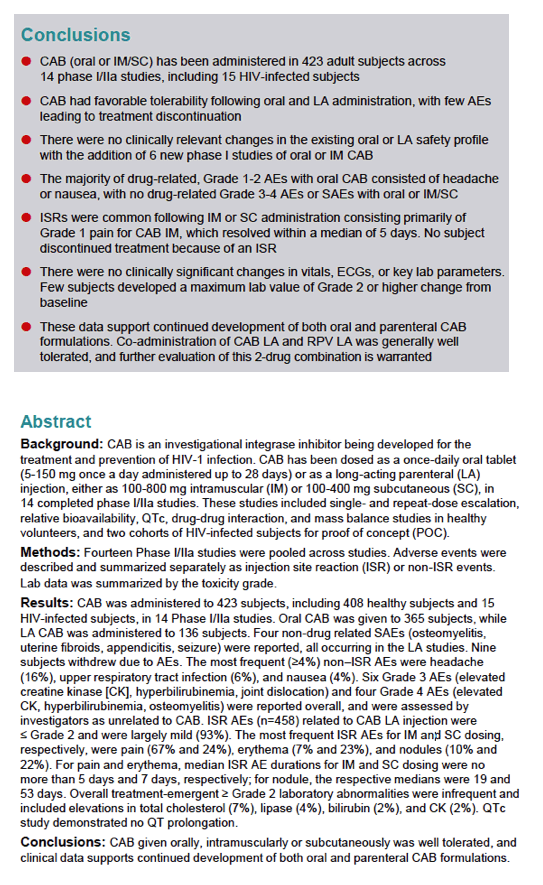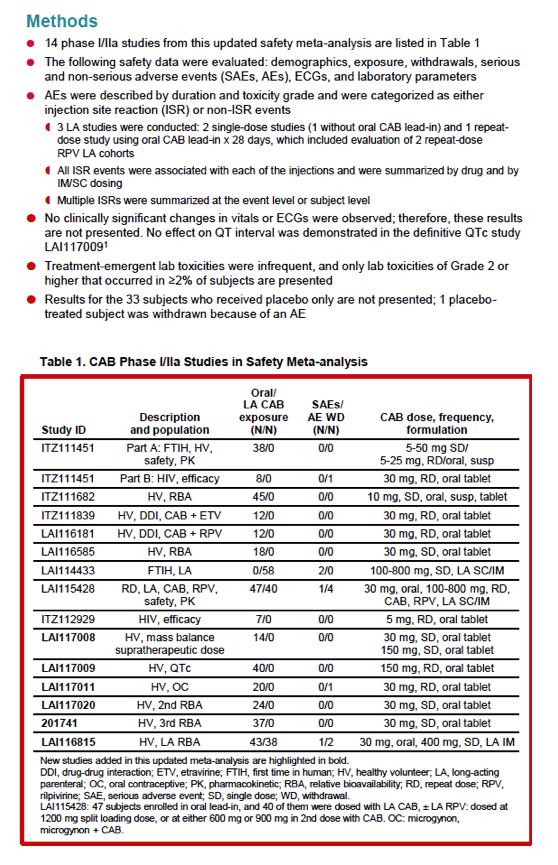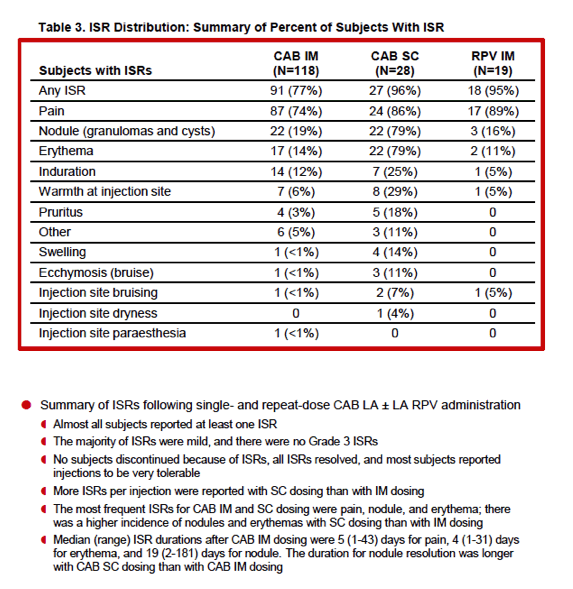 |
 |
 |
| |
Fourteen-Study Analysis Summarizes Safety of Injected and Oral Cabotegravir - Cabotegravir (CAB) Safety Meta-analysis Update From 14 Phase I/IIa Studies
|
| |
| |
IDWeek 2016, October 26-30, 2016, New Orleans

Mark Mascolini
Almost everyone receiving intramuscular or subcutaneous cabotegravir in a meta-analysis of 14 phase 1 or 2a studies had injection site reactions (ISRs), but all ISRs resolved and no one dropped out of the studies because of ISRs [1]. Only 4 of 423 people withdrew from one of these short-term trials because of drug-related adverse events.
Ongoing trials are assessing oral and injected cabotegravir, an integrase inhibitor, for HIV treatment and prevention. Two phase 3 treatment trials will test maintenance therapy with intramuscular cabotegravir/rilpivirine at 400/600 mg every 4 weeks after oral induction therapy or ongoing treatment and after a 600/900-mg cabotegravir/rilpivirine loading dose [2,3].
To provide information on safety of injected or oral cabotegravir, PAREXEL and ViiV Healthcare researchers conducted a meta-analysis of 14 phase 1 or 2a trials involving 423 people, 408 of them healthy volunteers and 15 with HIV infection. While 365 participants received oral cabotegravir (5 to 150 mg for up to 28 days), 136 received long-acting injected cabotegravir (100 to 400 mg subcutaneous or 100 to 800 mg intramuscular every 4 weeks or every 12 weeks for up to 4 injections).
Eight people withdrew from the studies, 4 because of drug-related adverse events: dizziness, rash, leukopenia, and elevated liver enzymes. There were no grade 3 or 4 drug-related adverse events with oral or injected cabotegravir. The most common non-ISR grade 1 or 2 adverse events were headache in 5% and nausea in 2%. The most frequent grade 2 or higher lab abnormalities were elevations in total cholesterol in 7%, lipase in 4%, creatine kinase in 2%, and bilirubin in 2%.
During the trials 118 people received intramuscular cabotegravir and 28 got subcutaneous cabotegravir. (Ten people got both an intramuscular dose and a subcutaneous dose.) Almost everyone had at least one ISR. No one had a grade 3 or 4 ISR, no one dropped out because of an ISR, and all ISRs resolved during follow-up. ISRs proved more common with subcutaneous cabotegravir than with intramuscular administration. Phase 3 treatment trials will use intramuscular cabotegravir.
With intramuscular cabotegravir, ISRs most often involved pain (74%), nodules (19%), erythema (14%), or induration (12%). ISR-related pain lasted for a median of 5 days (range 1 to 43), erythema for a median of 4 days (range 1 to 31), and nodules for a median of 9 days (range 2 to 181).
References
1. Lou Y, Gould E, Fu C, et al. Cabotegravir (CAB) safety meta-analysis update from 14 phase I/IIa studies. IDWeek 2016, October 26-30, 2016, New Orleans. Abstract 1513.
2. Spreen W. Cabotegravir long-acting (LA) injectable nanosuspension. 17th International Workshop on Clinical Pharmacology of HIV and Hepatitis Therapy, June 8-10, 2016, Washington DC. Invited lecture.
3. ClinicalTrials.gov. Study to evaluate the efficacy, safety, and tolerability of long-acting intramuscular cabotegravir and rilpivirine for maintenance of virologic suppression following switch from an integrase inhibitor in HIV-1 infected therapy naive participants. ClinicalTrials.gov identifier NCT02938520. https://clinicaltrials.gov/ct2/show/NCT02938520
Cabotegravir (CAB) Safety Meta-analysis Update From 14 Phase I/IIa Studies

Yu Lou, MS1; Elizabeth Gould, BS2; Caifeng Fu, MS1; Allan Tenorio, MD3; William Spreen, PharmD3; Parul Patel, PharmD3; David Margolis, MD, MPH3
1PAREXEL International, Durham, NC; 2PPD, Wilmington, NC; 3ViiV Healthcare, Research Triangle Park, NC




|
| |
|
 |
 |
|
|